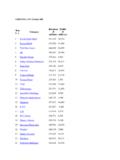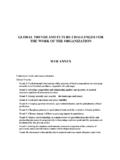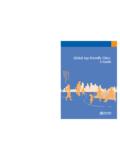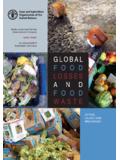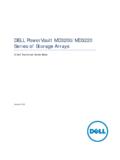Transcription of GLOBAL HEALTH RISKS - who.int
1 GLOBAL HEALTH RISKSGLOBAL HEALTH RISKSWHOM ortality and burden of disease attributable to selected major risksMortality and burden of disease attributable to selected major risksGLOBAL HEALTH RISKSiiWorld HEALTH OrganizationWHO Library Cataloguing-in-Publication DataGlobal HEALTH RISKS : mortality and burden of disease attributable to selected major Risk factors. 2. World HEALTH . 3. Epidemiology. 4. Risk assessment. 5. Mortality - trends. 6. Morbidity - trends. 7. Data analysis, Statistical. I. World HEALTH 978 92 4 156387 1(NLM classification: WA 105) World HEALTH Organization 2009 All rights reserved.
2 Publications of the World HEALTH Organization can be obtained from WHO Press, World HEALTH Organization, 20 Avenue Appia, 1211 Geneva 27, Switzerland (tel.: +41 22 791 3264; fax: +41 22 791 4857; e-mail: Requests for permission to reproduce or translate WHO publications - whether for sale or for noncommercial distribution - should be addressed to WHO Press, at the above address (fax: +41 22 791 4806; e-mail: designations employed and the presentation of the material in this publication do not imply the expression of any opinion whatsoever on the part of the World HEALTH Organization concerning the legal status of any country, territory, city or area or of its authorities, or concerning the delimitation of its fron-tiers or boundaries.))
3 Dotted lines on maps represent approximate border lines for which there may not yet be full mention of specific companies or of certain manufacturers products does not imply that they are endorsed or recommended by the World HEALTH Organization in preference to others of a similar nature that are not mentioned. Errors and omissions excepted, the names of proprietary products are distin-guished by initial capital reasonable precautions have been taken by the World HEALTH Organization to verify the information contained in this publication. However, the published material is being distributed without warranty of any kind, either expressed or implied.
4 The responsibility for the interpretation and use of the material lies with the reader. In no event shall the World HEALTH Organization be liable for damages arising from its use. Printed in publication was produced by the Department of HEALTH Statistics and Informatics in the Information, Evidence and Research Cluster of the World HEALTH Organization (WHO). The analyses were primarily carried out by Colin Mathers, Gretchen Stevens and Maya Mascarenhas, in collaboration with other WHO staff, WHO technical programmes and the Joint United Nations Programme on HIV/AIDS (UNAIDS). The report was written by Colin Mathers, Gretchen Stevens and Maya Mascarenhas.
5 We wish to particularly thank Majid Ezzati, Goodarz Danaei, Stephen Vander Hoorn, Steve Begg and Theo Vos for valuable advice and information relating to other international and national comparative risk assessment studies. Valuable inputs were provided by WHO staff from many departments and by experts outside WHO. Although it is not possible to name all those who contributed to this effort, we would like to particularly note the assistance and inputs provided by Bob Black, Ties Boerma, Sophie Bonjour, Fiona Bull, Diarmid Campbell-Lendrum, Mercedes de Onis, Regina Guthold, Mie Inoue, Doris Ma Fat, Annette Pr ss-Ust n, J rgen Rehm, George Schmid and Petra were prepared by Florence Rusciano, and design and layout were by Reto Sch HEALTH Introduction Results Joint effects of risk factors A: Data and methods.
6 Definitions,. ,. :. ,. :.. ,. :. ,. :. 55ivWorld HEALTH :. :. ,. :. :. ,. :. ,. ;. ,. :. ,. ,. ,. :. ,. ,. ,. ,. :. ,. ,. :. ,.world,. :. ,. ,. :.Definitions,. ,. :. ,. :.. ,. :. ,. :. :. :. :. :. :. ,. :. ,. ,. :. (DALYs). ,. ,. :. ,. :. ,. ,.. ,. :. ,. ,. :. ,. :. ,. ,. :. ,.world,. HEALTH RISKSS ummaryThe leading GLOBAL RISKS for mortality in the world are high blood pressure (responsible for 13% of deaths globally), tobacco use (9%), high blood glu-cose (6%), physical inactivity (6%), and overweight and obesity (5%). These RISKS are responsible for raising the risk of chronic diseases such as heart disease, diabetes and cancers.
7 They affect countries across all income groups: high, middle and leading GLOBAL RISKS for burden of disease as measured in disability-adjusted life years (DALYs) are underweight (6% of GLOBAL DALYs) and unsafe sex (5%), followed by alcohol use (5%) and unsafe water, sanitation and hygiene (4%). Three of these RISKS particularly affect populations in low-income countries, especially in the regions of South-East Asia and sub-Saharan Africa. The fourth risk alco-hol use shows a unique geographic and sex pat-tern, with its burden highest for men in Africa, in middle-income countries in the Americas and in some high-income report uses a comprehensive framework for studying HEALTH RISKS developed for The world HEALTH report 2002, which presented estimates for the year 2000.
8 The report provides an update for the year 2004 for 24 GLOBAL risk factors. It uses updated information from WHO programmes and scien-tific studies for both exposure data and the causal associations of risk exposure to disease and injury outcomes. The burden of disease attributable to risk factors is measured in terms of lost years of healthy life using the metric of the disability-adjusted life year. The DALY combines years of life lost due to premature death with years of healthy life lost due to illness and disability. Although there are many possible definitions of HEALTH risk , it is defined in this report as a factor that raises the probability of adverse HEALTH out-comes.
9 The number of such factors is countless and the report does not attempt to be comprehensive. For example, some important RISKS associated with exposure to infectious disease agents or with anti-microbial resistance are not included. The report focuses on selected risk factors which have GLOBAL spread, for which data are available to estimate pop-ulation exposures or distributions, and for which the means to reduce them are leading risk factors identified in this report (childhood underweight, unsafe sex, alcohol use, unsafe water and sanitation, and high blood pres-sure) are responsible for one quarter of all deaths in the world, and one fifth of all DALYs.
10 Reducing exposure to these risk factors would increase GLOBAL life expectancy by nearly 5 risk factors (alcohol use, tobacco use, high blood pressure, high body mass index, high choles-terol, high blood glucose, low fruit and vegetable intake, and physical inactivity) account for 61% of cardiovascular deaths. Combined, these same risk factors account for over three quarters of ischaemic heart disease: the leading cause of death worldwide. Although these major risk factors are usually asso-ciated with high-income countries, over 84% of the total GLOBAL burden of disease they cause occurs in low- and middle-income countries.












